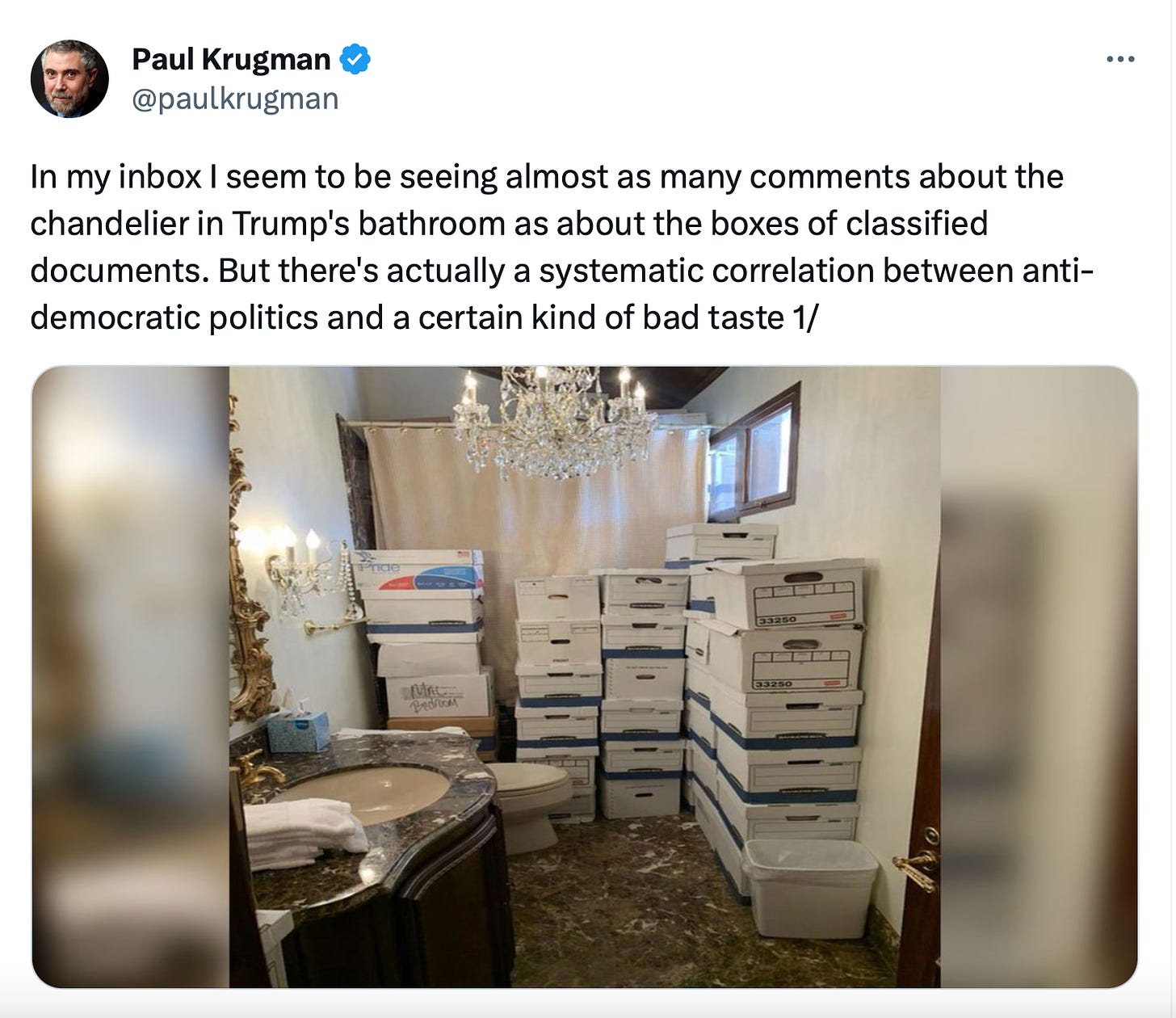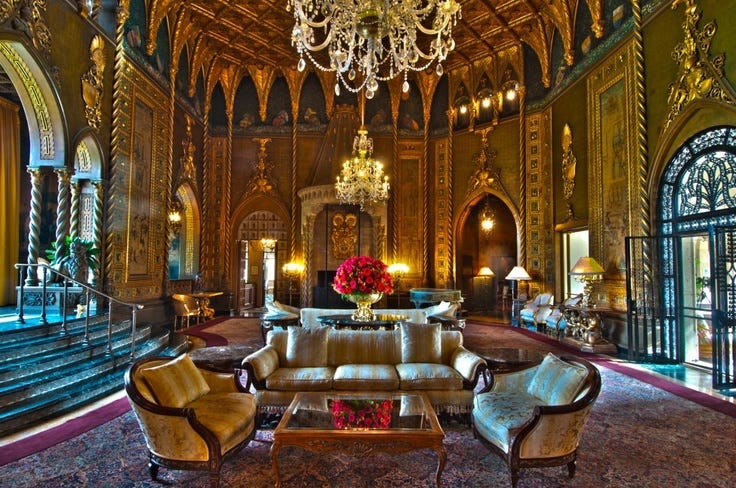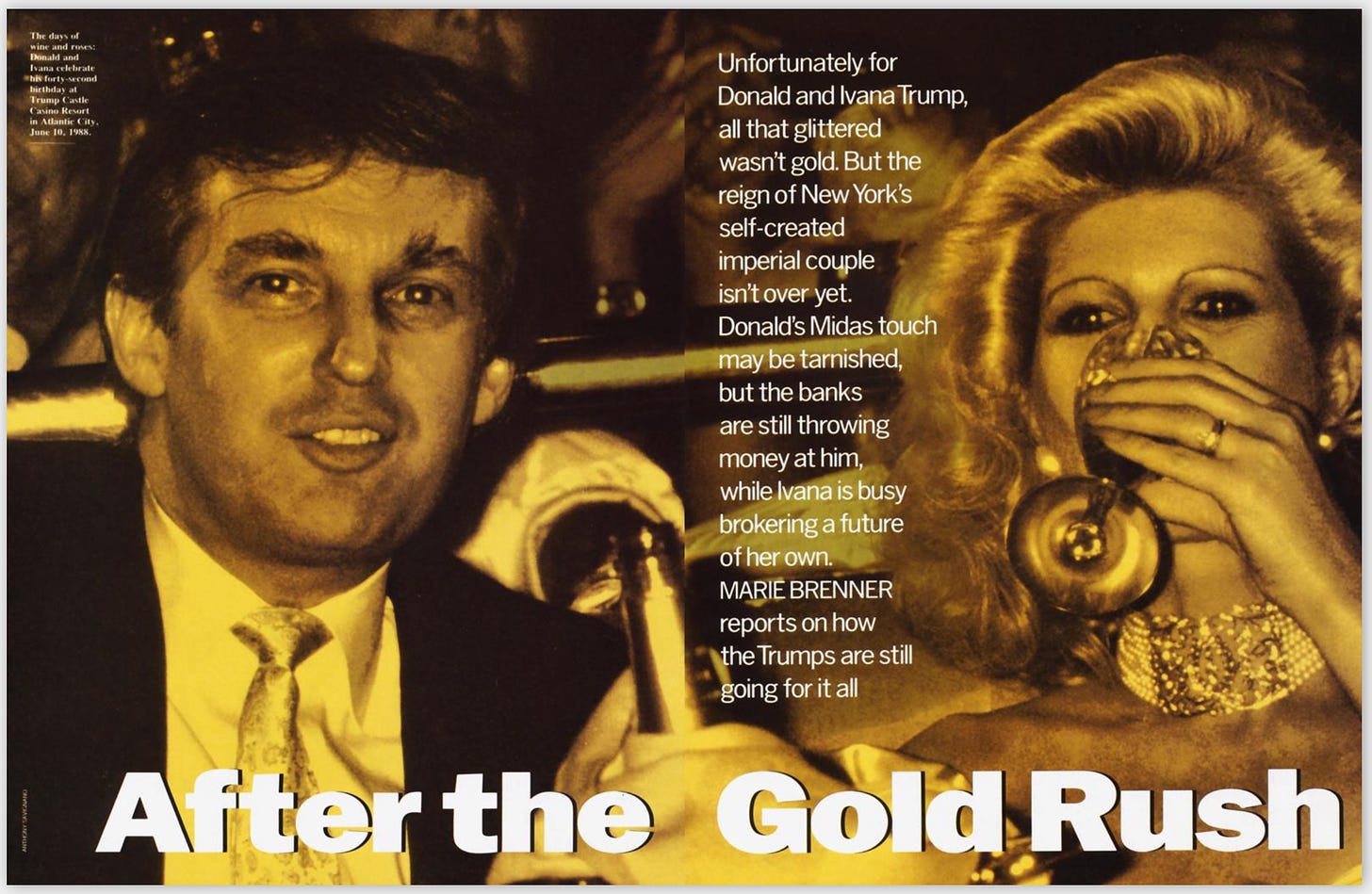Among the Thugs
In this week's back issues: the authoritarian style of Donald Trump
Welcome back to Culture Club, a feature where David and I write about what we’ve been reading, watching, playing, and listening to, for paid subscribers. Please enjoy this free preview, and consider upgrading to support two struggling journalists at once! — Talia
This weekend, after photos were released showing government boxes stacked in a conspicuously ornate Mar-a-Lago bathroom, the decor got nearly as much attention as the treason. Paul Krugman tweeted that Donald Trump’s particular brand of “bad taste” seemed to suggest authoritarian inclinations:
Krugman went on to share “Trump’s Dictator Chic,” a 2017 Politico article by Peter York, design columnist for Britain’s Sunday Times and author of 2006’s Dictator Style: Lifestyles of the World’s Most Colorful Despots. “At one level, [Trump’s style] is aspirational, meant to project the wealth so many citizens can only dream of,” wrote York. “But it also has important parallels—not with Italian Renaissance or French baroque, where its flourishes come from, but with something more recent. The best aesthetic descriptor of Trump’s look, I’d argue, is dictator style.”
York’s piece sent me down an online rabbit hole of reading into where Trump got his taste, and who might have inspired it. As you might have guessed by now, that rabbit hole inspired tonight’s newsletter, another dive into the internet’s vast reservoir of archival magazine content. I found a number of juicy features on Trump’s initial glass-and-brass-fueled rise and fall—including a pair by Marie Brenner, in New York and Vanity Fair, respectively—as well as two good New Yorker pieces by Adam Gopnik about the history of the modern tyrant.
When you start obsessing over the lives of humanity’s most evil specimens, it rarely ends well. But I was shocked to discover how humanely these monsters were portrayed in the contemporary press. Whether it’s the Atlantic on Mussolini, the New Yorker on Hitler, Time on Stalin, or the New York Times on Mao, the subjects are inevitably depicted as men of the people who would gladly spend more time with their doting families—if only there wasn’t so much work to do on behalf of their devoted subjects.
These stories also suggest that the twentieth century’s worst dictators were more interested in power (and cruelty) for it’s own sake than is our current crop of would-be autocrats, whose primary concern seems to be the pursuit of luxury. A century ago, Mussolini—the original fascist blowhard—would have felt right at home in Trump’s sitting room at Mar-a-Lago … but he would have turned it into his office.
Donald Trump’s Gilty Pleasures
Trumping the Town
By Marie Brenner
New York Magazine, Nov 17, 1980
“Their house isn’t a home; it’s a stage set: platforms, mirrors, twinkly lights, a bar, black malachite cube coffee tables, shell and silver accessories from Carole Stupell, no toys on the floor for a three-year-old, no clutter, just hard-edged charm. The Trump apartment looks like one of the luxury suites at the Grand Hyatt, a place designed for the future without a thought to the past, a place designed to entertain in, impress, ascend. A place just like Trump Tower will be, a monument where out-of-towners like the king of Saudi Arabia, Sofia Loren, and Donald and Ivana Trump will live.”
Inside Ivana’s Role in Donald Trump’s Empire
By Michael Shnayerson
Vanity Fair, January 2, 1988
In the limousine, we move on to happier subjects. How does she feel about all this talk of Donald running for president? And is her own ultimate goal to be First Lady? “It’s not for the next ten years, definitely not,” Ivana replies quite seriously. “There is so much to do. We have invested in this town close to a billion dollars. We can’t just put it in escrow and go to the White House. It would go down the drain in a second. It’s too young, too new. But in ten years Donald is going to be just fifty-one years old—a young man. What he’s done in the last ten years some corporations don’t do in a hundred years. Donald is interested in politics at a certain level. But I don’t think he would run for mayor—he could do that so easily. That wouldn’t be a challenge for him.”
Ivana may also feel that the White House would provide a better showcase for her own talents than Gracie Mansion. Imagine a First Lady who could redecorate it more professionally than any of her predecessors. (And who’s to say the Oval Office wouldn’t look better in pink marble with a waterfall along one wall?) Ivana’s European perspective wouldn’t hurt, either: she speaks fluent German, French, Czech, and ... Russian. With her casino savvy, she’d be a perfect consultant on the economy. And for the all-important task of overseeing White House social affairs and the service staff, what better experience could one have than overseeing not one but three palatial residences?”
After the Gold Rush
Marie Brenner
Vanity Fair, September 1990
“We have an old custom here at Mar-a-Lago,” Donald Trump was saying one night at dinner in his 118-room winter palace in Palm Beach. “Our custom is to go around the table after dinner and introduce ourselves to each other.” Trump had seemed fidgety that night, understandably eager to move the dinner party along so that he could go to bed.
“Old custom? He's only had Mrs. Post’s house a few months. Really! I'm going home,” one Palm Beach resident whispered to his date.
“Oh, stay,” she said. “It will be so amusing.”
It was spring, four years ago. Donald and Ivana Trump were seated at opposite ends of their long Sheraton table in Mrs. Marjorie Merriweather Post’s former dining room. They were posed in imperial style, as if they were a king and queen. They were at the height of their ride, and it was plenty glorious. Trump was seen on the news shows offering his services to negotiate with the Russians. There was talk that he might make a run for president. Ivana had had so much publicity that she now offered interviewers a press kit of flattering clips. Anything seemed possible, the Trumps had grown to such stature in the golden city of New York.
Donald Trump’s Tower of Trouble
By Wayne Barrett
Village Voice, December 17, 1991
When Trump Tower opened in 1983, its golden entrance, 80-foot waterfall, and rose-peach-and-orange-colored marble atrium quickly established themselves as the most photogenic symbols of Trump glamour. Donald launched a $2 million promotional campaign, complete with a lavish brochure promising the ultimate in luxury—hairdressers, masseuses, limousines, helicopters … all at your service with a phone call to your concierge—making the tower the place to buy. In a masterstroke of media deception, he even floated the rumor that Prince Charles was thinking of moving in at Fifth Avenue and 56th Street. But the clientele never did get that exclusive…
Your Trump Tower neighbors are as likely to be Medicaid cheats, coke dealers, mobsters, or those who may have gotten a touch too friendly with mobsters. Take, for example, Verina Hixon, a strikingly beautiful Austrian divorcee with no visible income (or alimony), who, in 1982, bought six apartments on the tower’s 64th and 65th floors for about $10 million. (Trump Tower is really 58 stories high, but Donald had juggled the floor numbers, skipping 10 flights and renumbering it as if it were a 68-story structure.)
Keep reading with a 7-day free trial
Subscribe to The Sword and the Sandwich to keep reading this post and get 7 days of free access to the full post archives.







